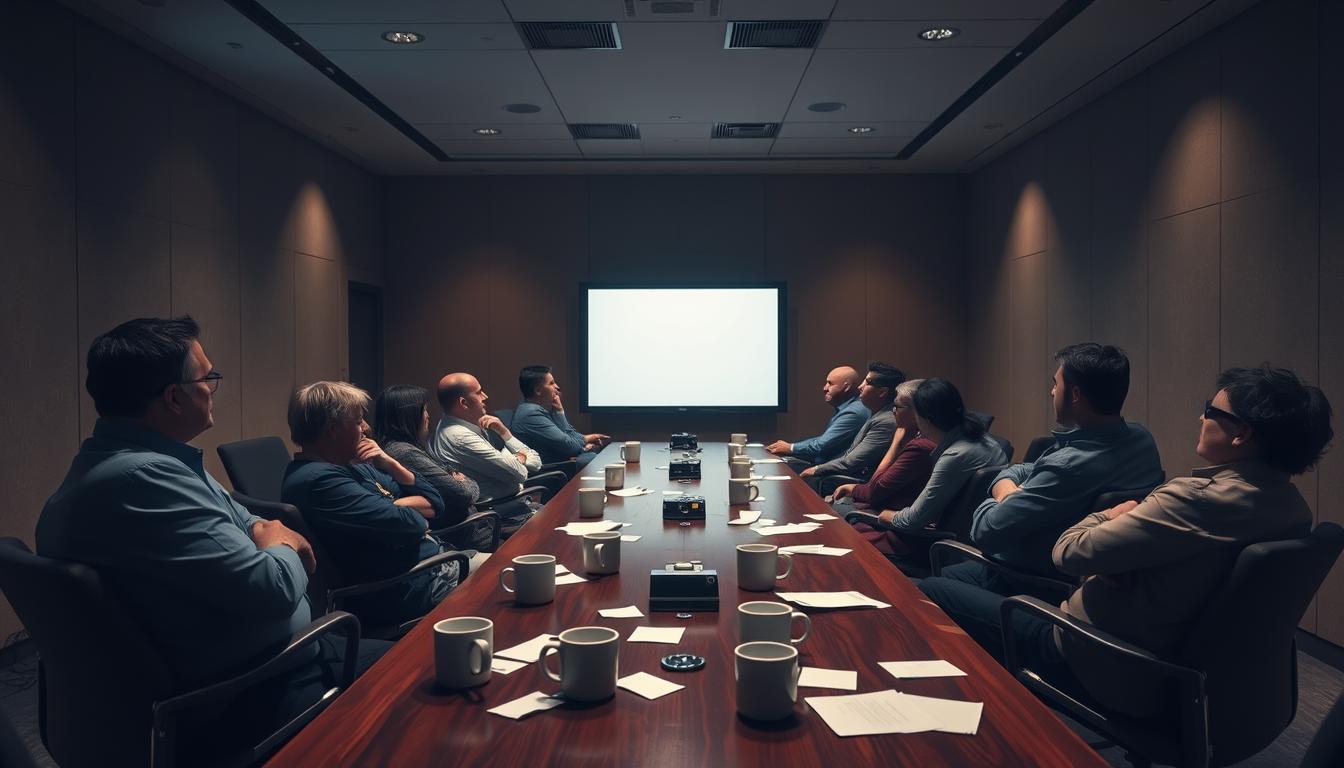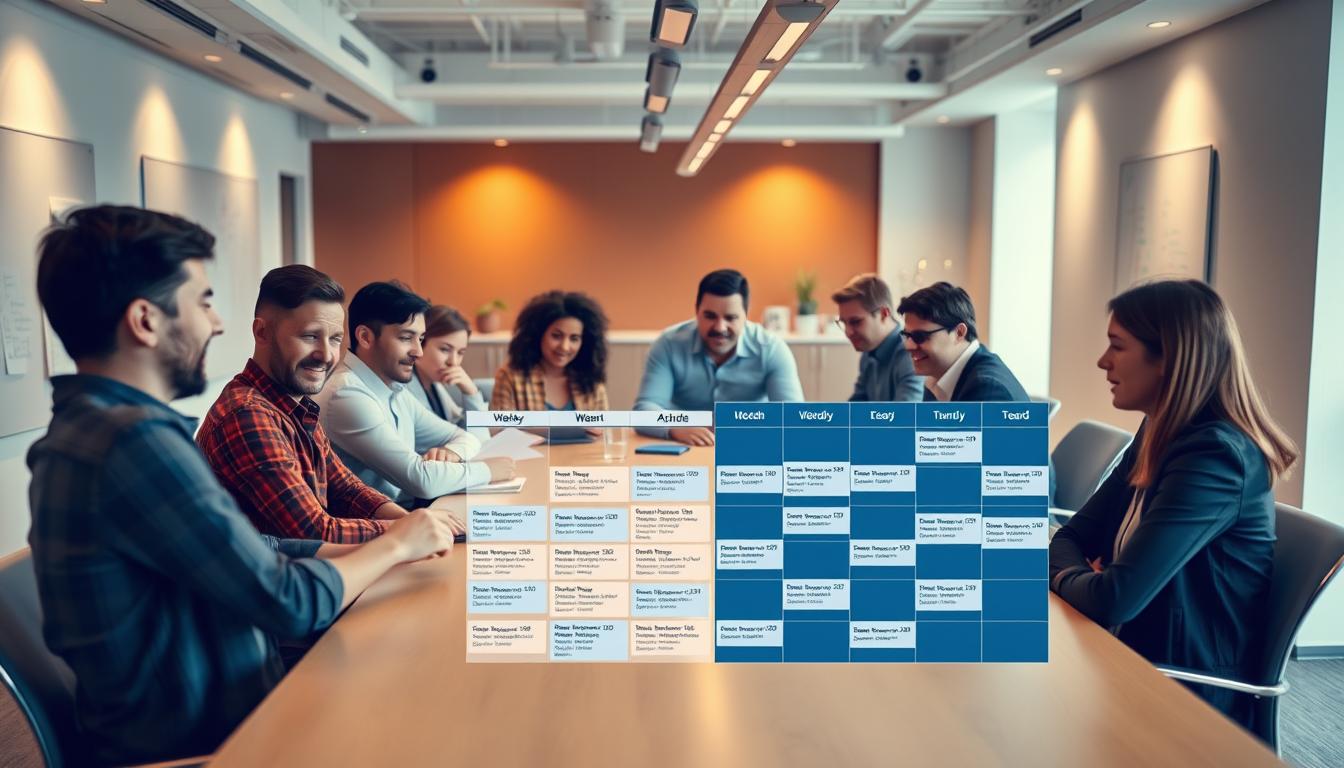In today’s fast-paced business world, having fewer meetings is key to increasing work productivity. Many organizations now understand that well-run meetings can boost efficiency. On the other hand, too many aimless meetings can be exhausting and slow down progress.
Studies show that up to 80% of workers worldwide feel they don’t have enough time or energy for their jobs because of poor meetings. To make a company more productive, there needs to be a change. Focus should be on hosting meetings that are direct, short, and interactive.
This change helps employees focus more on their main tasks. It also makes meetings a time for team members to collaborate and come up with new ideas.
Understanding the Importance of a Minimal Meeting Culture
Today, too many meetings are bogging down organizations. These frequent and unplanned gatherings make sessions unproductive and fail to motivate employees. A leaner meeting approach is crucial. It boosts productivity and creates an efficient workplace.
Why Current Meeting Cultures are Ineffective
Workplaces struggle with meetings because there are too many and they’re poorly planned. Studies show meetings often cram in too much information, like endless PowerPoints. This leaves no space for real conversation. Indeed, 57% of meetings are unplanned, and 10% are hastily set up. This chaos hurts work efficiency, leaving employees feeling buried and disconnected.
The Impact of Ineffective Meetings on Productivity
Bad meetings can sap energy and create disorder. Too many meetings disturb focus and slow down work. Staff caught in this cycle struggle to stay energized and dedicated. It’s vital to hold fewer meetings that are better planned. This will help overcome these productivity hurdles.
Identifying the Hidden Costs of Ineffective Meetings
Ineffective meetings can lead to many hidden costs that hurt how well we work. One key problem is the energy drain, especially for leaders. They face too many meetings without breaks, which can tire them out. This tiredness makes it hard for them to lead well and push their teams to do better.
Energy Drain and Leader Fatigue
Having too many meetings without breaks can make leaders feel worn out. They often feel like they can’t control their schedules and get stressed. When they have to attend more meetings, their energy goes down. This lack of energy can affect the whole company, making it hard for leaders to motivate their teams.
Increased Work Fragmentation
Too many meetings can also break up our work too much. Being pulled into meeting after meeting makes our work feel chaotic. About 52% of workers say they feel disorganized because of constant meetings. This chaos makes it hard to stay focused, leading to less work getting done and making everyone feel less happy at work.
Recognizing the Signs of Meeting Overload
Many organizations see too many meetings happening at the last minute and more unplanned gatherings. These meetings make it hard to stay productive and focused.
Frequency of Last-Minute Meetings
Last-minute meetings often don’t have a clear plan or goals. Studies show that 57% of meetings are set up without enough warning. This leads to talks that don’t stay on track and waste time.
Seeing a lot of these rushed meetings shows that a team is always reacting, not planning. This hurts the team’s work and stops them from focusing on what’s important.
The Rise of Ad Hoc Meetings
There’s also been a big jump in meetings that aren’t planned ahead of time. These spur-of-the-moment meetings usually aren’t well prepared and don’t have a specific topic. This can cause confusion and in worst cases, result in conflict on goals in the team. It lowers the overall work quality.
It’s vital to notice and fix these patterns. Doing so can help create a culture with fewer, more focused meetings. This improves efficiency and concentration.
Implementing Strategies for a Minimal Meeting Culture
Organizations can create a culture with fewer meetings by using smart strategies. These methods boost productivity and make meetings more meaningful. Setting clear goals for each meeting helps focus the conversation and get the results you want.
Also, making agendas ahead of time encourages everyone to stay on topic. This keeps meetings efficient and ensures everyone knows what’s expected.
Setting Clear Meeting Objectives
Having specific goals for meetings is key. If everyone knows the objectives, they can bring useful ideas to the table. This makes meetings run smoothly, focusing on reaching those goals.
Encouraging Meeting Agendas
Using detailed agendas is important. They list what will be discussed, so everyone comes ready. This leads to more involvement and better meeting outcomes.
Limiting Attendees for Efficiency
To make meetings more effective, only include people who need to be there. Keeping the group small cuts down on distractions. This helps create productive meetings.
Promoting Engagement Through Intentional Meeting Design
To make meetings engaging, focus on design that invites everyone to join in. If meetings are interactive, they become lively idea exchanges. This activity improves outcomes and boosts teamwork.
Utilizing Interactive Formats
Interactive elements are key to making meetings interesting. You can add:
- Brainstorming sessions that invite creativity and innovation.
- Breakout groups that allow for deeper discussions on specific topics.
- Real-time feedback tools that gauge attendee reactions and thoughts.
Using these methods makes meetings fun and gives everyone a chance to speak up. It shows that all voices are important.
Encouraging Participation from All Attendees
For the best meeting design, create a setting where everyone wants to share. Try asking for thoughts from shy members or start with icebreakers. These steps get everyone talking, bringing varied views and more engaging discussions. Prioritizing involvement like this builds a welcoming, effective meeting culture.
Key Components of Effective Meetings
To have effective meetings, focus on making them shorter and adding breaks. Shorter meetings with breaks help everyone stay focused. They also make the team more lively, making work more fun.
Shortening Meeting Duration
Keep meetings short and to the point. Cutting down meeting time keeps everyone interested and discussions productive. With shorter meetings, teams can reach their goals faster. This makes for better participation and clearer talks.
Scheduling Breaks Between Meetings
It’s important to have breaks during the day. Breaks let everyone breathe and get ready for what’s next. This way, meetings become more effective, helping the team do better and feel more connected.

Creating a Thriving Meeting Culture that Energizes Teams
A strong meeting culture boosts the team’s physical and emotional health. Adding movement to meetings can wake up participants, making them more focused and productive. By using methods that make both body and mind feel better, groups can create a lively, cooperative, and innovative environment.
Physical Vitality: Incorporating Movement
Adding physical activity to meetings is key for energy and creativity. You could have walking meetings, stretch breaks, or short workouts. These not only fight tiredness but also improve teamwork. Try these ideas:
- Walking meetings to talk and move at the same time.
- Planned breaks for stretching or simple exercises.
- A relaxation spot for breaks in long meetings.
Emotional Vitality: Fostering Connection
Emotional health is essential in a supportive meeting atmosphere. Building connections boosts teamwork and spirits. Leaders need to ensure everyone feels important and listened to. To foster this, you might:
- Use team-building activities.
- Encourage everyone to talk and listen for better bonds.
- Have feedback times for sharing ideas and feelings.
Measuring the Success of a Minimal Meeting Culture
Organizations must check if a minimal meeting culture works well. They should use different ways to measure success. Getting feedback helps teams share their thoughts on meetings. This feedback helps leaders improve their meeting methods. Also, seeing how meetings affect work quality is key.
Gathering Feedback from Team Members
Talking to team members after meetings can show if the meetings help. You can get their ideas through:
- Surveys that ask how they felt about the meeting
- Anonymous forms for honest feedback
- One-on-one chats for more detailed thoughts
This feedback helps teams make meetings better quickly.
Tracking Productivity Metrics
Keeping an eye on work progress shows how less meetings affect work. Look at how fast projects are done, work quality, and time spent on tasks. These signs help tweak meeting routines to improve work flow. Good tracking means knowing that fewer meetings really help.
Conclusion
In today’s fast world, we need fewer meetings. It’s a must. Long meetings often waste time and kill productivity. Organizations should see this and make meetings short and to the point.
Creating a culture of fewer meetings helps everyone work better. It makes workers happier too. When meetings are clear and needed, teams work better together. This makes the workplace better, where people enjoy working together and new ideas bloom.
By having fewer, focused meetings, work gets better. It makes every meeting important, improving work and growth. Adopting this can change how teams work together, making companies more successful.



